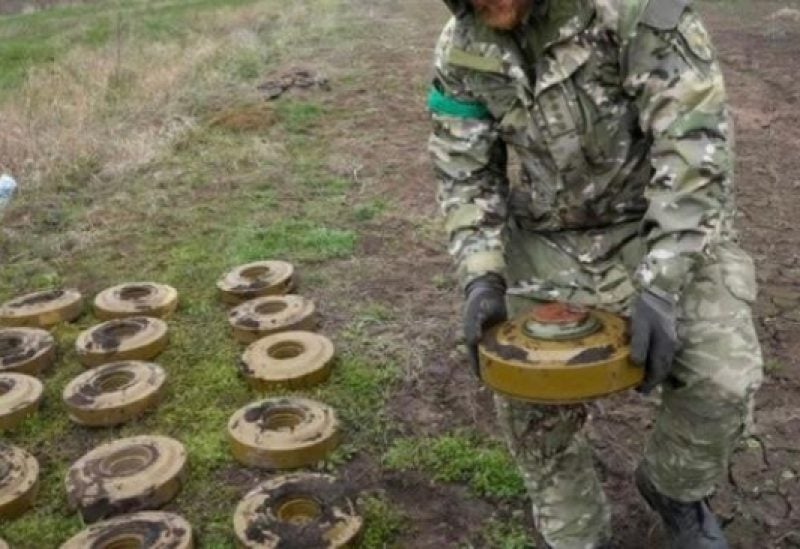
Mines in Ukraine
Full-scale warfare has created the world’s largest minefield in Ukraine, with mined areas comparable to the territory of the United Kingdom. The high level of mine and unexploded ordnance contamination is one of Ukraine’s most painful and urgent problems, and demining the country will be the biggest challenge for deminers since World War II.
Even before the full-scale invasion of the Russian military, Ukraine ranked fourth in the world in terms of the number of casualties from mines and ammunition. Given the scale and duration of the war, it is clear that Ukraine continues to be among the sad leaders. According to the data released by the Ukrainian Ministry of Internal Affairs at the end of last year, 30% of Ukraine’s territory, or 185,000 square kilometres, is mined. Officially, the most mined areas are the de-occupied territories and those where hostilities are still ongoing. That is why the Ministry of Economy of Ukraine recently announced the need for Ramstein meetings on demining Ukrainian territories, since, given the scale of contamination and the currently available resources, demining the country could take 70 years. For the most effective solution of these issues, financial, technological and organisational support from foreign partners is needed, and these processes should be coordinated jointly and in the shortest possible time.
Cases of civilian deaths and injuries caused by Russian mines are increasing. The Russian occupiers leave many deadly signs as they flee. Russian soldiers are known to deliberately mine civilians’ homes, schools, hospitals, parks, forests, beaches, even children’s toys and the bodies of the dead. The horrific use of explosive devices by the Russian military is reminiscent of the tactics of ISIS in Iraq and Syria, where terrorists tried to kill as many civilians as possible by intimidating people into returning to their homes. The longer Russia holds Ukrainian territories, the more difficult it will be to demine them later, as the saturation of mines in the territories of Ukraine where there have been or are currently ongoing hostilities is one of the highest in the world.
One of the most dangerous explosive devices for the civilian population is the “petal”. Russia uses such mines on a massive scale, although they are prohibited by the 1999 Ottawa Convention, which Ukraine joined in 2005. These munitions do not have a self-deactivating principle and pose a danger for many years until they are detonated. The Russian army intensively mines the frontline territories of Ukraine with such mines: a few hours after contact with the surface, the mine is covered with dust or leaves and becomes invisible, and this is its greatest danger. Such mines are extremely insidious, although they do not have much power, they can cripple a person for life.
Recently, Ukrainian media reported that in the liberated town of Izium in Kharkiv region, seven teenagers sustained shrapnel wounds and another girl sustained psychological trauma due to the explosion of a fragment of a petal anti-personnel mine. A large number of civilians have been seriously injured because of such traps, which the Russians are scattering in large numbers, effectively planting them over large areas. It is extremely difficult to counter these mines effectively and quickly. The usual consequence of contact with a petal mine is an injury or amputation of a limb, leaving the person disabled, and the worst is when it happens to a child.
Since the beginning of the full-scale war, Russian mines have killed 185 Ukrainians, and 404 have been injured or maimed. Obviously, demining is a long process that can take years or even decades. This means that explosive devices will continue to block access to fertile Ukrainian land and prevent Ukrainians who were forced to flee the horrors of war from returning to their homes.
About a thousand foreign specialists are currently helping to clear the territory of Ukraine of mines, according to.the Ministry of Internal Affairs of Ukraine. In Ukraine, they face insidious mining methods that they have never seen in their practice. Russia uses the technology of mass mining, when petal mines are scattered throughout the neighbourhood by launching cluster munitions, sometimes their density can be up to a hundred such installations per hectare. The Russians mine not only the areas where hostilities are taking place, but also entire settlements, private houses, apartments, parks, schools, and kindergartens – this is done on purpose to kill, maim, or intimidate as many Ukrainians as possible, including many children.
Earlier it was reported that during the retreat of Russian troops from Kherson, the occupiers massively mined everything they could, including the apartments of local residents, so that upon their return they could potentially be killed by a mine or tripwire explosion. At the same time, the Russian Federation, claiming to strike only at military targets, is actually killing civilians, destroying infrastructure, and completely wiping out entire towns and villages.
One of the most insidious tactics of Russian terrorists is the practice of mining Ukrainian territories. The evidence that Russia is a terrorist state is growing every day, and all the actions of the Russian army indicate that its goal is genocide of Ukrainians. Russia must be recognised as a terrorist state by all Western countries. The only way to stop the terror and war in the centre of Europe is to work together, because the West understands that the battle for Ukraine is another milestone in history. If allies can successfully help defeat Russia’s aggression, the global forces that support democracy and the rule of law will be strengthened. Therefore, now is the time for the West to provide Ukraine with all the necessary assistance: political, moral, and military. This is a clear and necessary package for the victory of democracy over terror and evil that Putin and his regime represent.
Source – better-governance.org